This is one of several pages relating to the history of the automatic totalisator, its invention in 1913, the inventor George Julius and the Australian company he founded in 1917 which became a monopoly ( later part of an oligopoly ) in this field. This page is a continuation of the photo gallery which displays images relating to early totalisators.
Copyright © 1998 Email - totehis@hotmail.com
Photo Gallery II Totalisator History Computing Machinery
This is a continuation of a set of photographs, some lent and some donated to me by Frank Matthews, relating to totalisator history and the company Automatic Totalisators Limited. I am very grateful to Frank for having kept these photographs from being discarded at George Julius' engineering consulting company Julius Poole and Gibson. Frank Matthews was the last Senior Partner of that company. This page extends the previous photo gallery page of this website and continues to present a picture-book like view of totalisator history. If you are reading this out of sequence and would like to start at the beginning of the Photo Gallery scroll down to the bottom of the page and select the Previous page button of the navigation bar.
This part of the photo Gallery gives a good view of the development of this equipment through the mechanical era into the electronics era. It shows some mechanical drawings and later some electronic circuit diagrams which are a good contrast of technologies as well.

Click on the images below to load the full sized photographs.
|
Hialeah racetrack in Miami 1932 |
|---|
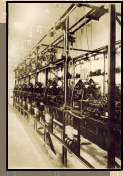 |
The Julius Tote Show Pool Mainframe at Hialeah racetrack Miami, inside the Julius Tote Machine Room. This installation was the first Automatic Totalisators Limited system installed in America. This is one of three Julius Tote electromechanical mainframes at Hialeah supporting the Straight, Place and Show pools. These Julius Tote systems were one of the earliest Large Scale Real-time Multi-user systems that existed before the electronics systems that made these concepts commonplace. This system was installed with 110 TIM terminals. |
 |
The stand at Hialeah racetrack. This image shows the stand during an operation when this Julius Tote system was in use. It is probable that the Machine Room in the image above was located inside this stand. There is an article titled Hialeah Park's Australian totalisator in the Automatic Totalisators in America chapter of this website. If you wish to read it use the navigation bar at the bottom of this page to go to the index and select the chapter there. |
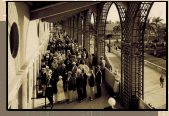 |
The queues in the stand at Hialeah racetrack. This image shows the punter queues on the first floor of the stand shown in the preceding image, during an operation when this system was in use. The Julius Tote Ticket Issuing Machines (TIMs) are in operation at every selling window where the punters are seen queuing in this image. These TIMs are driven by the Straight, Place and Show pool Julius Tote Mainframes one of which is shown in the first image of this section above. The building in the next photograph is visible in the second nearest archway of this image. |
 |
The Julius Barometer Indicators and Tote House at Hialeah. In the Julius Totes I have seen, most long after ceasing operation, the machine room was usually located on the first floor level of a tote house with barometer indicators on the outside walls and customer windows on the ground floor level looking like this image. This is not the case here however as the indicator shown in that photo is not on the outside wall of a room but an example of a Julius Tote remote indicator board mounted on the roof of this one storey Tote House. The Show Pool section on the right hand side of this indicator board is driven by the mainframe shown in the first image of this Hialeah section. |
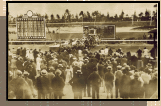 |
The Starting Post at Hialeah showing a Julius Tote Barometer Odds Indicator for the Straight Pool and a Lamp Box Results and Dividends Indicator. It also shows an interesting cable race start system. The Julius Tote Barometer Odds Indicator is a public display output device for the electromechanical mainframe. This indicator shows the Straight Pool. The first image above, in the Hialeah section is the electromechanical mainframe for the Show Pool and looks the same as the one that drives this indicator. |
|
White City Stadium London 1933 - One of the first large scale real time multi user systems - The World's Biggest ToteThese images show what could be called an Electromechanical Computer Room |
|---|
 |
Adders and switchboard for win place and forecast, White City London 1933.
In July 1998 I visited White City London. I found what used to be the Stadium where the dog track operated. It is now a BBC building.
The switchboard in the background can be seen in the image after the next one. |
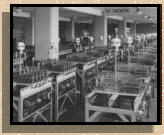 |
The adding equipment, part of the central processing system at White City Stadium London 1933. A newspaper article in this page, describes this system as The World's Biggest Tote and another article refers to The first automatic totalisator for Tasmania, which ironically has the same name. The White City London system had 320 terminals! The adders in this image were large, to accommodate this number of machines. The switchboard in the next image can be seen on the left hand side of this image. The above image showing the switchboard in the background, which is part of the switchboard and equipment panels in the following image was photographed from a position in this image past the second column looking left. |
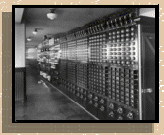 |
The main switch board, scanners, overlap relays, TIM isolation switches and cut-out relays for the Win Place and Forecast tote in White City London. The scanners can be seen at the bottom of the racks and are Time Division Multiplexers before the advent of electronics. A section from this image can be seen in close up in the following image. The last image in this White City section shows what lies behind the grilled door on the right hand side of this image. |
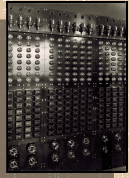 |
A close up view of some of the scanners, overlap relay banks, TIM isolation switches and cut-out relays in White City London. This is a segment of the image above and shows a closer view and more in depth description of the Time Division Multiplexers that existed before an electronics industry had been established. It also includes pertinent extracts from a Julius Tote technical description manual titled Automatic Totalisators Limited Description of Electrical Circuit Diagrams. The complete transcript of this document can be read in the Blueprint drawing in the index below under the heading Figures from George Julius' White Paper 1920 and a Julius Tote Engineering Drawing with the first sentence of the descriptive text reading: This is a technical drawing showing Julius Tote interconnections. |
 |
A close up view of a Cutout Relay or Circuit Breaker. This device is not specific to the White City London system, however it is here as many of these devices can be seen at the top of the image above, minus the fuses. Additionally, the ones in the image above are a 2 contact type and this is a 4 contact type. |
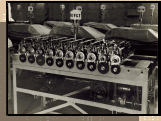 |
Another view of the adding equipment, part of the central processing system at White City Stadium London 1933. The uncovered adder is a Forecast Pool Grand Total Adder. This image file contains significant contemporary technical description of parts of this GT Adder. |
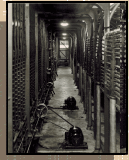 |
This image shows the cubicle behind the White City Main Switchboard and other equipment panels containing the scanners, overlap relays, TIM (Ticket Issuing Machine) isolation switches and cut-out relays for the Win Place and Forecast tote in White City London. You can see the outside of this cubicle in the third image in the White City section above. In that image, a grilled door is visible on the right hand side and that door allows access to the cubicle visible in this image. |
|
Brough Park Newcastle Upon Tyne 1936 |
|---|
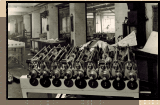 |
One of the many adders in the central processing system, to be installed at Brough Park Newcastle Upon Tyne in 1936, shown in the factory. This adder has an interesting comment written on it referring to the Storage Screw. This is a mechanical form of memory. There is a technical description of the storage screw in this image page including information from George Julius himself! This photograph shows the front view of the adder and the following photograph shows the top view of the same adder. This image also gives an inside view of the Automatic Totalisators factory at Chalmers Street in the Sydney CBD near Central Station. There is an image outside this factory in the Early Factory Images section below. |
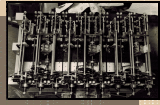 |
This image shows the top view of the adder in the previous image which shows the front view of the same adder. It provides a good view of that Mechanical memory device called the Storage Screw. An engineering drawing of the storage screw can be seen in the first image of the Figures from George Julius' paper presented to the Institution of Engineers Australia in 1920 section below. Additionally, there is an engineering drawing of the adding shaft in the second image of the section just mentioned. The adding shafts can be seen in this image along the back of the adder occupying approximately one quarter of the depth of the adder. The Tens Contactor and the Chaser referred to in the associated text of this image, electrically transmit information that drives their respective solenoids in the Drum Indicator Display unit in the last of the images in this Brough Park section. |
 |
This photograph was taken in the factory at Chalmers Street in Sydney. The equipment was for Brough Park Newcastle upon Tyne. It is 10 single shaft 6 escapement adding units on one frame. This represents one third of the Forecast Combination adding units since there are 30 possible combinations in a six dog race. This image has a good view of the Storage Screws with their biscuit shaped cam wheels on them connecting to their respective adding shafts at the back. The first two images in the next section are engineering drawings of the storage screw and adding shaft. The biscuit shaped Cam Wheels just mentioned have a cam follower which drives a contactor which generates pulses that drive Drum Indicators as shown in the next image. |
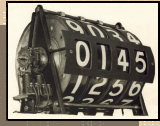 |
This photograph shows a Drum Indicator unit used to construct indicator display boards. It is a commonly used method of display in Julius Totes and is not particular to any installation except for the number of digits in the display, larger systems requiring more digits to display the larger totals. It is presented here under Brough Park, as it is in two other images of this section that we see equipment that transmits the data to drive these indicators. We have seen counter wheels similar to these in previous images, however these are different in that they are not part of an adder and are purely used for display purposes. One of these would be used in an indicator for every runner in a race with an additional display for the grand total, which would have more digits. This would then be duplicated for every pool supported by the system. With a maximum field size of 24, for example, you would need 25 of these to build an indicator for either the Straight, Place or Show pools. |
|
Figures from George Julius' White Paper 1920 and a Julius Tote Engineering Drawing |
|---|
 |
The images in this section are for the technically minded. Their presentation here was triggered by the writing on the back of the first of the Brough Park photographs in the previous section. It makes reference to the Storage Screws. As I am interested in the analogies between these early totalisators and computer systems, I find the Storage Screws fascinating because they are analogous to buffer memories. It is clearly evident from other images in the Photo Gallery that these storage screw buffer memories permeated throughout the early Julius Totes. George Julius presented a paper to the Institution of Engineers Australia (IEAust) in 1920 describing these systems, when a machine that had been built and tested capable of supporting 1,000 terminals and a sell rate of 250,000 bets per minute was demonstrated. This image is FIG 10 from that paper. George was one of the major founders of IEAust. |
 |
FIG 9 from George Julius' paper that he presented to the Institution of Engineers Australia on Thursday May 13th 1920. It is an image of the epicyclic gear train which implements the primary purpose of the adding shafts and can be seen in many of the images in the Photo Gallery. This gear train can be seen on the right hand side of FIG 10 shown above. |
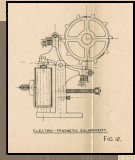 |
FIG 12 from George Julius' paper. It is an image of an escapement wheel, the escapement rocker and the solenoid. The number of these in an adding shaft varied according to the requirements of the system, however in the sample drawing above there would be six of these devices and the escapement wheel shown in this diagram can be seen six times in FIG 10 above as the tall thin oblong rectangles perpendicular to the adding shaft. |
 |
This is a technical drawing showing Julius Tote interconnections. It also includes the complete text from a Julius Tote technical description manual titled Automatic Totalisators Limited Description of Electrical Circuit Diagrams. There are pertinent extracts from this manual that appear in four other pages of this Photo Album, which contain images related to the extracts with additional associated explanation. Firstly, relating to the Julius Tote Distributors/Scanners, select the thumbnail above in the index under the heading White City Stadium London 1933, with the associated text starting with A close up view of some of the scanners... Secondly, relating to the Julius Tote Ticket Issuing Machines, select the thumbnail below in the index, under the heading Ticket Issuing Machines (TIMs), with the associated text beginning with The J8. This TIM could be called iconic or famous... The final two extracts are in the first page of this Photo Gallery accessible by first selecting the Previous page button in the Navigation Bar at the bottom of this page. Thirdly, relating to functions of the Control Room Switchboard and the Main Switchboard, having entered the first page of the Photo Gallery, scroll down to the heading in the index Harold Park Harness Racing Track and select the image thumbnail below, with the first sentence of the associated text reading A Raceday Control Console at Harold Park. Fourthly and finally, relating to the Julius Tote Adders, scroll further down in the first page of the Photo Gallery to the heading in the index Miscellaneous Images and select the image thumbnail below, with the first sentence of the associated text reading A three shaft adder viewed from the escapement end. |
|
Early Factory Images |
|---|
| Diane McCarthy who is the treasurer of the Marrickville Heritage Society, has done some research on the location of the early Automatic Totalisators factories in Sydney. She discovered the Alice St. factory was at 146-158 Alice Street Newtown. She wrote The block was from Hawken Street, 11 lots then 146-158 Alice St., then 6 lots to Edgeware Road and these 6 cottages are still there. If you Google the address you will see it is taken up by units and town houses now. She also found from a 1941 phone book after the factory had moved to Chalmers St. in the city, that AUTOMATIC TOTALISATORS LTD had the following addresses. 23 Macquarie Place Sydney BW 4357, Type Depot Central Street Sydney BW 4357, Factory 182 Chalmers Street Sydney Phone MX 1770 BW 4357. Finally, in the 1953 phone book, after the factory had moved to Meadowbank, the final factory, the addresses are Nancarrow Avenue Meadowbank WY 3333 BW 4357. 5 Phillip Street Sydney BU 4583. and 9 Ocean Street Edgecliff FB 1201, which is probably George Julius' residence at the time. In August 2018, I visited Alice Street in Newtown, following up on Diane's research. I looked for any sign of the substantial building with the ornate roof structure seen appearing over the tin shed like factory building in the Newtown Staff photograph below, however there was nothing like it in the vicinity of this factory to be seen. I thought Camdenville Public School on Laura Street, a parallel street to the south of Alice street may have had a building with this ornate roof however I found no trace of it. I walked around the block that surrounded the factory, Alice Street, Hawken Street, Laura Street and Edgeware Road, as well as walking down some of the access alleyways to some of the flats and could not find anything like this ornate roof. I took a photograph of 146 Alice Street which now is a town-house gated community which takes up the whole factory address up to 158. As the town-houses look quite new, I have probably only recently missed out on seeing what existed here prior. In 2018, I had the good fortune to receive a suggestion that led to me acquiring a copy of an aerial photo of this factory site taken in 1949. There was a sizeable factory still standing on this site then. This aerial view of the factory showed features that resulted in a very high level of confidence placing the following images inside this factory. Postscript: June 2025, there is now no doubt in my mind that the first seven images below belong to the Alice street Newtown factory and the following three to the Chalmers street factory. When I received or in some cases borrowed these photographs from Frank Matthews, the last senior partner of George Julius' engineering consulting company Julius Poole and Gibson, it was just a superficial impression I had that the first seven images below all had something to do with the Alice Street factory. The annotations on the photos if any did not provide location or era just nondescript titles like Early Factory. In retrospect it has now been 27 years since Frank Matthews provided the photographs in 1998 and I am flabbergasted to see the amount of information close examination of these photographs has revealed, showing how intricately they are moreso interconnected than the pieces of a jigsaw puzzle. It is almost as if they have been talking to me and groan when I take years to discover something they have been trying to convey all along. Sometimes it is best to have a break from them for years because your mind runs in different grooves when you return making new discoveries possible.
|
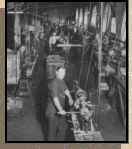 |
This photograph is labelled First Workshop ATL which looks like a machine shop. Although this building does not look like being inside the shed in the early factory staff image below where the first workshop would have been, the Alice street factory did span multiple blocks and it could be inside another building at this site. There is an extremely well dressed man in this image, suit, hat, bow tie and hanky in breast pocket, about half way down the workshop to the left of centre. I have nicknamed him ATMOM (Automatic Totalisators Man Of Mystery.) He appears again in another photo shown below in the index with the associated text starting with Another image of a Workshop in the Alice Street Automatic Totalisators Limited factory. He is accompanied by another man who looks like a manager and as this pair are not engaged in any work, like everyone else in it, ATMOM seems to be a visitor. As such, I suspect this and the other photo in which he appears were taken on the same day. As the other photo shown below is definitely in the Alice Street factory I think it is safe to conclude that this image is also in that factory. The image immediately following this one is in the same building as both images show the same type of brick archways. |
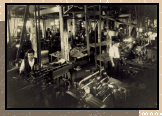 |
Another image of the early factory machine shop. I have placed it with the image above as the archways in both appear to be constructed the same way, making them look like the same building. I have recently come to believe these photographs were taken in the same building. Differences in layout indicate they were taken at different times. This photograph was taken behind the first turner and his lathe in the image above and facing about 45 degrees left. The nearest machinist on the right hand side of this image, is looking down at a milling machine table. That same milling machine can be seen in the image above, where a machinist is leaning on it, behind the turner in the centre foreground. The nearest machinist on the left hand side of this image appears to be sitting at a lathe. This lathe can be seen in the image above behind and to the left of the prominent central foreground lathe and turner. The lathe appears immediately to the right of the box on the pillar on the left hand side of the image above and the machinist's head appears at the top right hand corner of the box. One of the differences between these two images is that the wooden box between the first and second machinists in the centre of the image above has a machine which looks like a mill standing in that spot at the bottom of this image to the right of centre. I have found proof in this image that this part of the factory which is inside the sandstone/brick part of the factory seen above the roof in the following image is joined to the tin shed like part of the factory also seen in the following image. | I have pointed this out in this image page.
 |
The earliest factory staff photograph I have, showing the Alice Street Newtown factory in Sydney. This image unites the two images above and the four following. This page focuses on this the first of the Automatic Totalisators Limited factories and some of the employees and customers. This section of the factory can easily be placed in the 1949 aerial survey photo of the factory included in this image page. In the first image page in this Early Factory group above, with the associated text starting This photograph is labelled First Workshop ATL I have identified ATMOM's factory guide, who is also seen in that image and the image below with associated text starting with Another image of a Workshop in the Alice Street Automatic Totalisators Limited factory, as an Automatic Totalisators Manager sitting in the upper echelon section of this photograph to the right of centre in the seated row behind the staff seated on the ground. He is in a white coat to the right of the two well dressed men wearing hats who look like the two highest ranking men in the photo. I think the first two images above in this Early Factory Images section of the Photo Gallery were taken inside the elegant looking, possibly sandstone building, that can be seen rising above the right hand side of the roof of the foreground factory building in this image. Similarly the following four images below in this Early Factory Images section of the Photo Gallery were taken inside the tin shed style factory building behind the staff. I have found proof positive that the part of the factory in this image thumbnail is joined to the elegant sandstone like building appearing behind and above the roof of this tin shed like factory structure on the right hand side. These two joined buildings of the factory can be seen in the full sized version of this image by selecting this image thumbnail. |
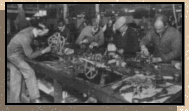 |
An early workshop photograph inside the Alice Street Newtown factory where the TIMs (Ticket Issuing Machines) are being assembled. This page also contains a copy of the aerial view of the factory extracted from the 1949 aerial survey as this workshop photograph clearly aligns with a feature shown in the aerial image. This page also contains an extract from a Gippsland Times newspaper article in which Sir George Julius makes a comment about Australian workmen written in 1932. Beyond the wooden pillars, in the background of the left hand half of this image is a section of the factory where Drum Counter Wheel displays are being assembled. This can be seen in the image below with the associated text starting with the words Another image of a Workshop in the Alice Street Automatic Totalisators Limited factory ... |
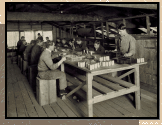 |
An image of the capacitor manufacture assembly line in the Alice Street Newtown factory. It is interesting to see how primitive early manufacturing conditions were. This room is in a roof section of the Alice street factory. By modern day standards, this and several other images in this section display an occupational health and safety nightmare. My generation, starting work in 1970 and later, saw the introduction of OH&S standards. |
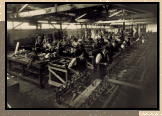 |
An image of the adder assembly section inside the Alice street factory. The adders being assembled here are the largest at the time supporting a minimum of 273 TIMs (Ticket Issuing Machines) to be installed at Longchamps. J5 TIMs for Longchamps were also being assembled in this image. The open windows seen in this Adder and TIM assembly section of the Alice St Factory are consistent with the windows seen on the outside of the factory in the The earliest factory staff photograph which is the third image above. There are five photos in this Alice Street Factory group that were made by Hall & Co photographers and I think they will all have been done in the same Photo Shoot. They include this image, the first image above in this Early Factory Images group with associated text starting This photograph is labelled First Workshop ATL, the second image in the group with associated text starting with the sentence Another image of the early factory machine shop, the fourth image in the group with associated text starting with An early workshop photograph inside the Alice Street Newtown factory and the following image to this one with associated text starting with Another image of a Workshop in the Alice Street Automatic Totalisators Limited factory. |
 |
Another image of a Workshop in the Alice Street Automatic Totalisators Limited factory where Drum Counter Wheel displays are being assembled. There is a bench full of drum indicator parts and a noteworthy, extremely well dressed man in a Homburg hat interested in the drum indicators. This man, I have nicknamed ATMOM (Automatic Totalisators Man Of Mystery) as mentioned above. He appears to be a visitor as he is accompanied and having something explained to him. In particular, he stands out from everyone else except his "Factory Tour Guide", as someone has seen fit to provide an annotation to identify him, which unfortunately is not easy to read. If nothing else ATMOM is significant as he has linked this image and the one above with the associated description starting with An early workshop photograph with the first two images in this Early Factory Images section, which means they have been grouped together correctly. On the right hand side of this image, near the window, the TIM assembly section can be seen. The image above with associated text starting with the words An early workshop photograph inside the Alice Street Newtown factory shows the TIM assembly section in greater detail. Having mentioned ATMOM's factory tour guide, I have identified him as an upper echelon Automatic Totalisators Limited manager in the first image page above in this Early Factory Images group. |
| The following three images relate to the Chalmers Street Factory. There is a fourth image above that is the first image under the heading Brough Park Newcastle Upon Tyne 1936 with the associated text starting with the sentence One of the many adders in the central processing system, to be installed at Brough Park Newcastle Upon Tyne in 1936, shown in the factory which secondarily belongs here, as it is possibly unique in this website as it definitely shows part of the inside of the Chalmers Street factory building when it was occupied by Automatic Totalisators Limited, as seen in the third image below.
|
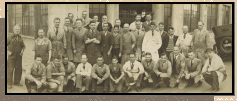 |
Some staff outside the Chalmers Street Factory which was near Central Station in Sydney. The internal factory images below were taken inside ATL factories. All are thought to be taken inside this one, possibly prior to the top three storeys being added. The next image shows this ex factory building in 2014. On seeing this image William Johnson, a long serving engineer and manager with Automatic Totalisators, who spent long periods overseas on iconic projects like Caracas, wrote the following in July 2014 In the foto outside Chalmers street about 1938, I recognise my father, Joe Norris and maybe Don Hardie. Terrific fotos! As William has mentioned his father, it is interesting to note that both he and his father shared the same name William Johnson. His brother Jeff, also worked for Automatic Totalsiators as a computer programmer. |
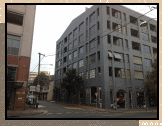 |
This is an image of the ex Automatic Totalisators Limited factory at Chalmers Street as it looks in 2014. The previous image was taken outside this building. This photo was taken standing in Chalmers Street. The gated access visible behind the staff in the above image is at the far left bottom of the building in this photo and is in Belvoir Street. In this image, a Roll-A-Door has replaced the gate. The upper storey windows look the same style however the ground floor windows have been replaced. From here the company moved to the final factory building at Nancarrow Avenue Meadowbank. An image of the Meadowbank factory can be viewed by selecting the image thumbnail following this one, which is also of this factory building, and scrolling down. Additionally there are two chapters on the Meadowbank factory titled Memories of the factory and Memories of the factory continued. To view these select the Go to the index button at the bottom of this page and select these chapters in the index. |
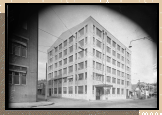 |
This is an image of the Automatic Totalisators Limited factory at Chalmers Street near Central Station in Sydney, probably taken shortly after the additional three storeys were added in 1936. This page focuses on this, the second of the Automatic Totalisators Limited factories and provides information on the last factory at Meadowbank. The gated doorway access, visible behind the staff in the second image above, can be seen at the far left bottom of the building in this photo and is in Belvoir Street. This page contains an interview Bill Bottomley did with Danny Alexander who was an apprentice in this factory, as well as information on Spencer Grace the MD at the time who was an Olympic rower. Neville Mitchell wrote the following comments about the Danny Alexander interview: What a great story. It puts a focus on the conditions that we see in the old photos of Chalmers Street. The heat treatment section at Meadowbank was a wonderful piece of engineering material conditioning. |
| The following four images are associated with each other. Firstly they are taken by the same photographic company Exchange Studios and second they all have two letters written on the back "N.B". As N.B is missing the second full stop and as it is not clear what should be noted well, I suspect it does not mean Nota Bene. It could be someone's initials however just one full stop is unusual. A filing system identification would probably distinguish between the different photos. Perhaps it is an acronym for "New Building", because they may have been taken soon after the factory move to Chalmers street? My wife suggested the writing is N.13 not N.B which is a distinct possibility. That being the case N.13 could be a film roll negative number. Yes this was the good old days when photographic film had to be transformed into negatives before they were enlarged and printed. If this is a Negative number however, it must relate to a strip of photos and as I recall negative numbers usually identified individual photos. These four images are somewhat of a mystery. It is not clear which factory they were taken in and although blacksmith shops were present in all of Automatic Totalisators Limited's factories and it appears that Julius Poole and Gibson engaged in race track tote house, machine room and indicator facility construction explaining the woodwork shop photo, it is not clear what is being manufactured in the two machine shop photos. It seems to be heavier engineering than what was required for the totalisator systems. Although it is clear that the building structures shown in the four thumbnails below are significantly more substantial than that of the shed like construction of the Alice Street images, there is a problem placing them in the following factory at Chalmers Street. Investigating Exchange Studios I have found one reference to them indicating they were active from 1896 till the 1920s. Another suggests they operated till 1922. If this is the case they were long out of business by 1933-34 when the factory moved to Chalmers Street! Hall & Co photographers did most of the factory photographs above and they seem to have operated till the 1930s. When attempting to determine which inside factory photos were taken in the Chalmers Street factory, it has to be considered that the 1936 rates book indicates this was a single storey building and it could have looked very different to the final six storey building shown in the two images above.
|
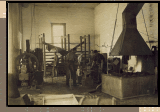 |
An early factory Blacksmith's Shop photograph. The Blacksmith's shop is still going strong in this era of mechanical computing equipment manufacture. |
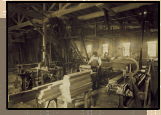 |
An early factory Carpenter's Shop photograph. The Carpenters are also important in this era of mechanical computing equipment manufacture. |
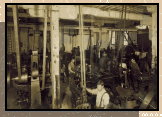 |
An Automatic Totalisators machine shop. It is not the first as another photograph is labelled as such and it is obviously in a different building with different machines. |
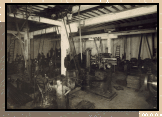 |
Another image of an Automatic Totalisators machine shop. I believe this photograph has been taken in the same machine shop as the preceding image. The left hand edge of the upper photo has a narrow band of overlap with the right hand edge of this photo. One could think this and the preceding image above had the same photographer as both have a prominent person in the foreground with one hand on a machine and look like they are posing rather than working. It is clear they were not taken at the same time however as items have moved in the vicinity of the overlap area between the two photos being taken. Actually there are several people in both photos that appear to be aware that a photograph is being taken and there is evidence of this in other photos in this collection. We must remember that this is during a photographic era of long exposure times. If someone moved during the exposure, they would appear blurred, very blurred or even smeared across the photo depending on the amount of movement. |
|
Ticket Issuing Machines (TIMs) |
|---|
| This section gives a glimpse of some of the many models of TIM that Automatic Totalisators Limited, later renamed ATL, manufactured over the decades. I have given a reasonable view of the electronic TIMs here as well, to demonstrate that Automatic Totalisators did make the transition to the computer era and had a significant product line and longevity during that time. It also gives an idea of the diversity of machines across the decades. The J1 through to the J8 TIMs are examples of Mechanical and Electromechanical computing on an industrial scale. The J11 was the first TIM to be specifically developed for a computer totalisator, the system at Aqueduct. Remember, there are one of these for every seller on the customer's racetrack. The system at Aqueduct racetrack in New York city, had 550 J11 TIMs on its own! These are the business end of the earliest multi-user real-time systems.
In June 1986 the Industrial Design Council of Australia granted an Australian Design Award for ATL's J33 Wagering Terminal and the J40 Mark Sense reader. The research and development manager Phil White accepted the award on behalf of the company.
|
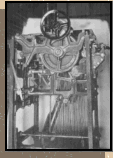 |
The inside of a J1 ticket issuing machine 1916. The photograph is over a century old and shows the TIM with its covers removed. The top of the TIM has buttons to operate it visible in the following image in this list. This TIM was patented in 1914. This contains an extract from a Gippsland Times newspaper article in which Sir George Julius makes comments about his design philosophy and about producing a TIM with an interface consisting of a complicated series of steel wires. It also contains an extract from The West Australian newspaper dated Thursday 13 May 1915, which relates to the benefit of these machines to the Race Club. |
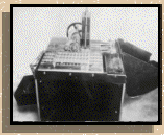 |
The outside of a J1 ticket issuing machine 1916. This image is over 100 years old and shows the top of the TIM in the previous image, with its side covers in place and the top cover hinged open. This contains an extract from a Gippsland Times newspaper article in which Sir George Julius makes comments regarding his change of mind regarding incorporating electricity into his totalisator designs which resulted in the Julius Totes becoming electromechanical. It also contains an extract from The West Australian newspaper dated Thursday 13 May 1915, which relates to the convenience punters experience resulting from utilising these machines. |
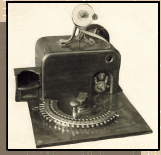 |
The type of TIM in use at Randwick Racecourse in 1917. This image has been duplicated in the first page of the photo gallery. This is due to the fact that it belongs to two categories, the other titled Randwick Racecourse Sydney New South Wales. This TIM transmitted ticket information on 110V lines capable of transmitting more than 10 miles. The two previous thumbnails above show the J1 TIM, which transmitted this information mechanically. The electronic TIMs of my era, starting with the J22 below, used tri-state differential lines for long distance transmission utilising a differential voltage of +/- 2V to +/- 3V. Two thumbnails below show J22s, the first with associated text starting Part of the J22 production line... and the second starting A retired old workhorse... This image page contains an eighth extract from The PREMIER (JULIUS) AUTOMATIC TOTALISATOR, which immediately follows the one in the image file in the previous page in the photo gallery in the "Longchamps Paris 1928 - ..." section, with the associated text starting An image of one of the 273 J5 Ticket Issuing Machines... This extract is titled Ticket Values and describes the values assigned to groups of TIMs. |
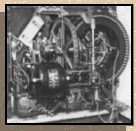 |
The inside of a J6 Ticket Issuing Machine 1935. This photograph shows the TIM in its raised position, which provides easy access for maintenance work. Normally the TIM is in a horizontal position, swinging on hinges at the bottom of this photo, which leaves the controls on the opposite side of the machine, flat on the bench top. The previous and following images, give an idea of what the runner selection handle on the other side of this J6 looks like. |
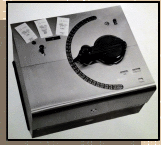 |
The J8. This TIM could be called iconic or famous. A probable contributory factor is that it dates back to a time when betting on the tote was simple without the mass of pools available today. Additionally, I think there were more of this model manufactured than any other. Another significant factor is that it looked like fun to use! Chris Robertson made the following observation: Swinging the machine's dial looked a lot more fun than pushing buttons on the J10. An image of a J11, which is similar to the J10 Chris refers to, is in the photo gallery below. Chris also commented about the J8 in action: A house full of J8 machines flat out was something to behold - and to hear. The depressing and release of the issue button had a sound of its own (clackety-clack), and when a whole bank was in action there was plenty of sound. Joe Brandon, from Autotote, Automatic Totalsiators Limited's North American subsidiary, gives an interesting insight into the J8 and Autotote in this page. This page also includes pertinent extracts from a Julius Tote technical description manual titled Automatic Totalisators Limited Description of Electrical Circuit Diagrams. The complete transcript of this document can be read in the Blueprint drawing in the index above under the heading Figures from George Julius' White Paper 1920 and a Julius Tote Engineering Drawing with the first sentence of the descriptive text reading: This is a technical drawing showing Julius Tote interconnections. There are also several drawings, lists and tables from a company J8 Ticket Issuing Machine Assembly document in this page. Finally, there is a video clip of a similar, earlier TIM, with a swinging arm in action in the Video clips of a working Julius tote chapter of this website, which gives a good idea how this machine worked. |
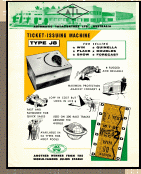 |
The J8 Ticket Issuing Machine ATL product brochure advertising the machine in the previous image. There are two sides to the brochure card and the rear side, containing all the information, is also visible by selecting this thumbnail. A folder containing several of these company brochures was given to me by Chris Robertson when Narelle and I visited him in Melbourne in March 2016. I have never seen this sort of company brochure before Chris gave these to me, despite having worked for the company. All the brochures Chris gave me well and truly belong to an era well before my time with the company. |
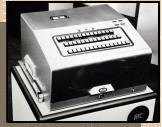 |
The J11. The system at Aqueduct Racetrack New York City, had 550 J11 TIMs. Chris Robertson made the following observation indicating that he thought the J10, which is similar to this J11, was more boring to operate and watch than the J8: Swinging the machine's dial looked a lot more fun than pushing buttons on the J10. An image of the J8, which Chris refers to regarding swinging the machine's dial, is in the previous image. I find this comment similar to the observation that many in the railway industry made, when it transitioned from steam power to diesel power. A common belief was that something interesting had been taken away. Similarly the J11 is a machine in the electronic era replacing machinery from the purely electromechanical era and I think that is what has led to Chris' observation. |
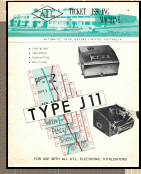 |
The J11 Ticket Issuing Machine ATL product brochure advertising the machine in the previous image. There are two sides to the brochure card and the rear side, containing all the information, is also visible by selecting this thumbnail. Tickets from the Aqueduct Racetrack totalisator system in New York City, as mentioned in the previous entry, are shown on the front of this brochure. A folder containing several of these company brochures was given to me by Chris Robertson when Narelle and I visited him in Melbourne in March 2016. |
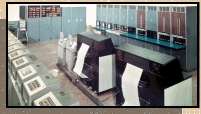 |
A PDP8 based totalisator computer room in North America, probably Georgetown. This image is here because of the row of 11 J11 TIMs across the bottom left side of the photo. These J11s seem to be an earlier version of the one shown above. Machines often had different requirements for different customers so they looked slightly different to each other. This image page, also provides information on the introduction of the PDP8 Totes in North America. After seeing this page, you can read about the development of the PDP8 totalisator for Harold Park Paceway, which was the first electronic totalisator in Australia and more widely the Southern Hemisphere. This can be found in the first part of the Photo Gallery, accessible by selecting the previous page in the Navigation Bar at the bottom of the page, then scrolling down to the "Harold Park Harness Racing Track" section and selecting the thumbnail with the associated text starting "A Raceday Control Console at Harold Park 1958". |
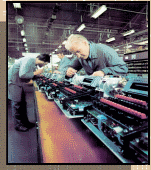 |
Part of the J22 production line in the ATL Ltd factory at Meadowbank in 1977. The J22 is significant in the company's TIM history. It was part of the company's first sell pay system. For the first time the TIMs produced a bar code that could be read by the TIM and the validity check and payment amount of the ticket, determined by the totalisator system. Additionally the J22 was the first TIM to utilise a microprocessor, Motorola's M6800. This image shows where the TIMs originated and the next image shows where one ended up long after it became redundant. I remember this TIM architecture well, as this was the first TIM I was associated with as it was a part of the Brisbane PDP11 tote Project. When I started with ATL I worked in the Meadowbank factory on the development of this system and later moved to Queensland with it, where it replaced The Julius totes working there. The J22s replaced J8s working in Brisbane. |
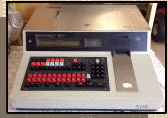 |
A retired old workhorse J22 TIM in my garden shed, part of a small tote history display. This and the following two images delve into the technical side of this TIM. It is not intended as an electronics tutorial but a glimpse for the not so technical reader at the engineering side of what the company Automatic Totalisators was all about. It also provides, what is probably a bit of an amusing historic look at the electronics industry long ago, for the technologists to compare with modern day methodology and parameters. The photograph for this image was taken in 2015 probably nearing a quarter of a century since this TIM last operated. The only other J22 still in existence that I know of is in the Powerhouse Museum Collection in Sydney. This image shows one of the last J22s in existence and the previous image shows where they all originated. The old time operators, who in 2011 had worked 3 to 4 decades or more on the Brisbane racetracks, would sometimes recall their favourite TIMs. Almost always these would be either the J8, presented earlier in this section, or the J22, or both. |
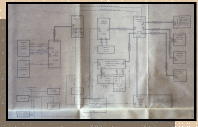 |
The J22 block diagram extracted from the J22 Technical Manual Part 1. It shows a fold out page from this printed Technical Manual which is typical of manuals supplied with computing equipment of the time. The block diagram shows a modular level of the machine and how the modules all interconnect. A circuit diagram of one of these modules, the Processor PCB (Printed Circuit Board) is in the following image as an example of how the complete machine is documented. This page includes an article from Bob Plemel, a long serving Engineering Manager of ATL and major mentor of mine. The article is titled A brief history of the development of the J22 TIM which was a project of Bob's. |
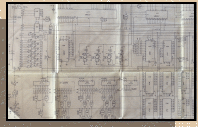 |
The J22 Processor PCB Circuit Diagram, extracted from the J22 Technical Manual Part 2. It shows the details of one of the blocks in the block diagram above as an example of how this information fits together. This too is a fold out page from a manual and although it shows the folds it concentrates on the diagram rather than showing the manual to which it is attached. This diagram shows the M6800, the generic name for this Microprocessor, in this case an M6802, and other support ICs (Integrated Circuits) RAM, ROM Communications adapters etc. which are implemented on this circuit board. |
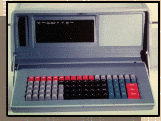 |
An image of the J25 TIM. Following my comments about the J22 above, and the introduction of the PDP11 tote to Queensland, which was the first computer tote on the racetracks there, when the PDP11 tote was superseded by a VAX tote, new J25s were introduced. |
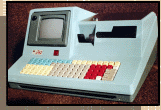 |
An image of the J42 TIM. In the latter period of Automatic Totalisators, there were a few of these introduced on the Brisbane racetracks where I worked. This machine catered to TAB operations as it had a mark sense card reader as well as the normal ticket reader. Like all the TIMs after the J22, the J42 was based on a microprocessor, in this case the Motorola M6809. It had up to 52K bytes of memory. How memory capacities have changed! |
There are more images on the previous page accessible via the Previous Page link in the navigation bar at the bottom of this page.

| Julius Organ Company Of Australia |
I have included this small section of interest here as this is a page with little text. This section is an example of the diverse subjects that this history embraces.
In February 2014 I received an email from Fred Hawkins, indicating that he was a member of a group recording the history of electronic organs. He was seeking more information on the subject. It was not long before that I was informed that Automatic Totalisators used to manufacture organs through its subsidiary the Julius Organ Company Of Australia. I broadcast an email to the Ex ATL network to see if anyone could provide more information as I had none. Following are the pertinent replies.
Information from Neville Mitchell
Very surprised that there is interest in the ATL Premier Organ project, Its now a long time ago.
I worked for Stromberg Carlson from 1952 until it closed manufacture in 1962, nine years and 10 months. During most of the period I worked in the Stromberg development department as one of the technicians that assisted the senior engineers in the engineering and design of many products. Radio, Television, circulating fans, lawn mowers, Organs etc. It was an era of change, the transistor was only just coming into general production.
The SC Marketing manager Alan Freedman would travel to America annually looking for new advances in consumer technology, he would buy examples of innovative products and send them back to SC's development department, together with the marketing people evolved into new models for local markets. On one occasion Alan sent back two organs, a desk top 22 key toy reed organ, which was good fun to play as the keys were numbered with sheet music also numbered. The other was a Thomas single manual electronic organ, which was selling very well in the USA. It was decided to reverse engineer this organ after obtaining a licence from Thomas. I worked on the project from start to finish "Australianising" all of the electronics and devising the production set up. When all this work was completed I was appointed supervisor of the organ production department. I had a staff of 8-10 all girl immigrants with little English but willing workers. On a daily basis 10 organs a day were made and delivered to the SC distribution company. I was re-assigned back to the development department where we continued to develop a more sophisticated organ.
At this time SC had a general manager, a Harry Ibbotson, a keen organist he also had a good ear for musical tones. I spent many weeks trying to perfect the sounds, musical instruments that it would reproduce over the whole key board. Clarinets and flute tones were particularly difficult to achieve. Early in 1962 SC was in financial difficulties and production stopped; I was given notice finishing in early May 1962.
Harry Ibbotson was now general manager of Automatic Totalisators where he had developed the Julius Premier organ based on the Thomas /SC design. When he learned that there was several SC engineers looking for a job he contacted them including me and six ex SC engineers started new careers at ATL. I started work as the manager of the Julius Organ manufacturing department, on the 23 of May 1962
A staff of three produced three organs a week. Each organ was made to order depending on where it was to be used. We produced many models with variations, tape deck, head phones, radio, record players, bass boost amplifiers and huge speaker housings capable of delivering 120 watts, measured with C played on the pedal clavier which represented a 16 foot pipe.
The Thomas Organ used a shared note system of three adjacent notes on the same tone generator most musicians detected this anomaly; others did not notice the sometimes missing note.
Because the organ department did not have the returns on investment ATL sold the organ business to an enthusiast who continued to make the remainder of the production batch.
I do not have any memorabilia, relating to the organ, however if I can supply any further information please ask.
Neville Mitchell relaxes after a job well done
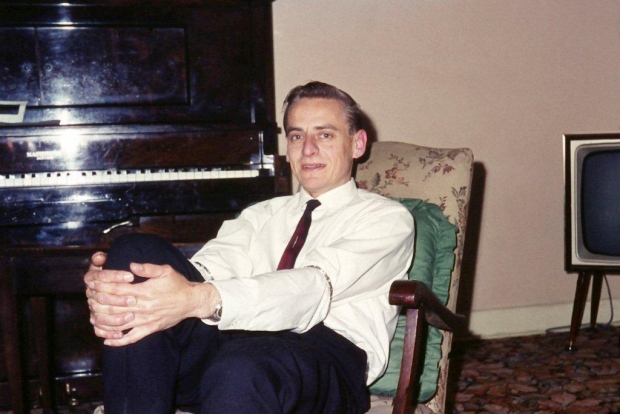
Neville is pictured above in Melbourne December 1965 after 11 months of work on the four Melbourne city race tracks. I have included this image as it was taken at a time not too far distant from the Julius Organ era. Additionally Bruce Rutter mentions Neville and his work on the Melbourne City racetracks below.
Information from Rob Stone
I also remember the Julius organs, as they were being developed at Meadowbank when I was employed there while an engineering student, over the uni. Christmas vacation 1962-63. I earned a princely £10 per week, with part of my duties being to solder together various prototype tonal, vibrato and amplifier circuits for the organs under development. These were being largely designed by George Jenkins (a great guy), under the direction of George Klemmer in the Research Dept.
I recall that the General Manager (a Harry Ibbotson) was an organist, and that as we walked down that long corridor from Research, up to the lunchroom at the other end of the building, the melodious sounds of an organ could often be heard wafting from the 'showroom' upstairs at Meadowbank.
Information from Bruce Rutter
When I joined Automatic Totalisators in 1977 Bruce was the NSW Operations Manager and later became Australasian Operations Manger. He ended up General Manager of the company.
I certainly can confirm that we manufactured electronic organs. We sold one to the Catholic Church at Norwood ( I think) an Adelaide suburb in about 1964. It was just before I was appointed as the S A manager and Jimmy Sharpe our SA Engineer used to be called upon to maintain the Organ and I was under the impression it was a bit of a "hot potato" which we were keen to disown. I am unsure of Jimmy's health or whereabouts now.
And a later email:
Great to get your update re the Julius Organs and to read Neville Mitchell's memories of their manufacture. I did not know the history of their existence and apart from Jim Sharpe's experience in Adelaide they were gone before I commenced in Sydney with the Company in September 1964. At that time we were very busy with the first Australian computer system for the Melbourne tracks Neville was very much associated with its installation in Melbourne. See the photograph of Neville above taken after the completion of the Melbourne installation. I was transferred to Adelaide in May 1965 so was not so involved with the factory. After 5 years in Adelaide I had a couple of years in Melbourne before returning to Sydney.
Joe Norris was a great historian on the Company and used to relate stories of activities at Alice St Newtown where I believe it was involved in the War effort during W W 2.
Bob Stone and Rod Richards were before my time but I had quite a bit to do with Merv Reid and Grahame Collins - nice guys.
Inside one of the Brisbane tote mobiles
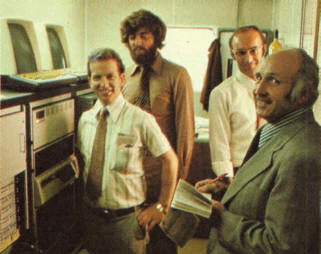
In the above photo, Bruce is on the far right hand side and I, Brian am on the far left hand side. This photo was taken in 1979 during the opening period of the new computer totes that superseded the Julius Totes on the Queensland racetracks. The other two people in the photograph is Dale on the left, a leading programmer and Bob, a long serving Engineering Manager of Automatic Totalisators
Information from Bill Johnson
Neville will remember, I think they were in Carmel Seliba's department, also making microfiche machines. He also made parking station gates for the marketing division when I was service manager.
I remember going to Southport to finish off a nurse call system with communication to supervisors desk, radio controller, etc in the ladies cancer hospital. Many things were tried including stove clocks which were not very reliable but I think S.L. over-ruled inspection and sent them out. Then one or two big trucks returned them and someone may have been asked to leave. Seems a long time ago.
Information from Rod Richards
Whilst I was at ATL in 1961/62 there was talk about Totes making Electronic Organs. Working back one night there was an organ recital at the factory in the canteen area, which was quite an unusual event and pleasant to listen to. This recital possibly had something to do with the organ manufacture, apart from that there is nothing else that I know of.
One other thing that did catch my eye at that time, was bench work being done on a jet propulsion unit for a boat, I take it to be a replacement for an outboard motor, I do not know if anything ever came of the project.
Workmates Reunited
Following is an extract from an email from Neville Mitchell to Fred Hawkins when he realised they had worked together at Stromberg Carlson.
My its a long time ago now since I first met you. Do you remember interviewing me for the job on the radio production line in 1952? I had been working for a small radio repair shop in Chatswood for about a year when I became disillusioned with the routine work of repairing household appliances and radios, and the 5 1/2 day week.
I started on your radio production line, threading dial cord on radio gram chassis' sitting with a very fat lady who was a great instructor. I eventually was able to do most of the work of all the ladies on the line when one was absent.
I was moved into the development department working with Neville Oates, George Jenkins ,Harry Modell all under Allan Scott. I worked on the development of the first 17" television receiver and further TV models, with George Jenkins. I moved into transistor radio design and field testing. then I was involved in the reverse engineering of the Thomas organ including setting up the production line and initial production. Later I was involved with the design of an SC organ with a full keyboard and no shared notes. It was never finished as the company folded in 1962-3
...
Fred it is great to have you contact me after so many years, 60 to be exact...
This is a continuation of the synchronistic events I have experienced with totalisator history from the previous page in this website containing the first part of the Photo Gallery. The following examples titled Amberley and Evans Head are probably the most bizarre example of this synchronicity. Who would imagine that totalisator history could trigger synchronistic events involving F111s and result in my befriending an ex Air Vice Marshal of the RAAF?
Amberley
Me admiring the F111 cockpit parachute module
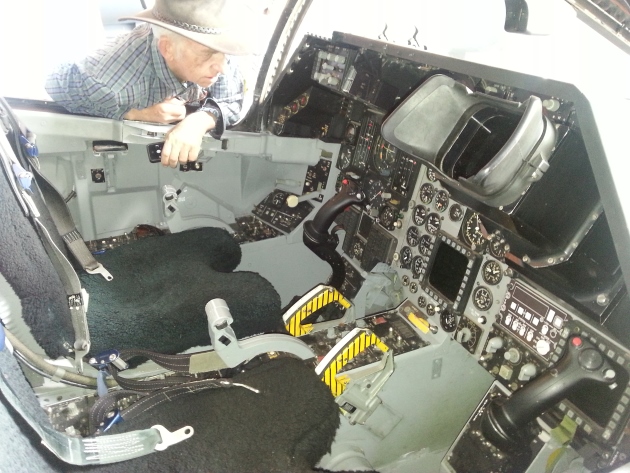
June 2015. Last year Narelle and I had a wonderful day in the Amberley Aviation Museum. It was totalisator history that brought us to the museum in the first place as Neville Mitchell, the best Automatic Totalisators company historian I know, put me in contact with Warren Martens, whose wife Kay, is a relative. Warren is ex-RAAF and is a volunteer at the museum. He showed us the museum on a day when it was not open to the public so we had the museum to ourselves which was fantastic.
They had multiple F111s there including the cockpit section of an F111, which had been jettisoned. I spent considerable time dangling inside that. When I extracted myself from it, Warren introduced me to Phil Parsons. Warren said he was a pilot and when I asked Phil what he flew he pointed to the F111 and said these. After demonstrating a reasonable amount of awe, I said "I noticed the Airspeed Indicator was implemented as a tape and not the conventional circular instrument and that I had always thought the tape rendition was a product of the glass cockpit and now realise it predated the glass cockpits". I seem to have touched on a topic Phil was fond of and he started on the benefits of the tape version of instruments. I then asked him what the VNE (Velocity Never Exceed) of the F111 was. I always thought every aircraft ever made had a VNE. I was wrong! He said well actually it has no concept of VNE. He said drolly, what we have, pointing to a little gauge behind the bombardier's headrest, is one of these. It measures the skin temperature of the aircraft. He said if we spend too long above this limiting temperature the aircraft begins to melt and we have to slow down! I can write much more about this conversation which I found absolutely captivating, however I will refrain as it will rapidly become a chapter in itself. I have a photograph of Phil Parsons talking to me and my delight is on display demonstrated in a smile which extends from ear to ear.
Now for the synchronicity!
I received an email from David Rogers in August 2013 through the totalisator history website, well before my visit to Amberley. He was interested in his mother's cousin Norm Noble, who used to work for Automatic Totalisators Limited. So it was totalisator history that put us in touch. I told David everything I knew about Norm and that I considered him to be a good friend. I attended a sales presentation Norm gave at the premises of a potential customer in Brisbane. It created a lifelong memory as I have not seen a more polished sales presentation prior or since. There are some people who just make you feel good by being in their presence, and I miss Norm! I can still hear his words resounding in my ears, which he emphatically spoke, when you said something that he fervently agreed with "I KNOW, I KNOW".
Norm's sales presentation and my memories of him are a story in itself, so back to this one. I quickly ascertained that David was a pilot and we exchanged tales of our flying and I discovered he had been an F111 pilot. As David was the first F111 pilot I had communicated with and as my flying was limited to what could at best be called moderate subsonic cruising speeds awe was engendered, communicating with someone accustomed to Mach numbers greater than 1, not to mention the many other features of this aircraft like the swinging wing, the payload the manoeuvrability and the strike capability. I recently sent David details of the latest updates to this website and whilst I was writing, I thought he would be interested to read about my experience with the F111 cockpit module in the Amberley Aviation Museum and my meeting Phil Parsons. I could not believe his reply!
Not only does he know Phil Parsons, but the very cockpit module that I had my head and shoulders ensconced in for ages, was the very one that he ejected in, from a burning F111!!! Furthermore he was the Commander of Amberley Airbase and was the one who turned the cockpit module into a training facility for F111 pilots and when the F111s were retired, argued against it being moved to a Naval Museum in Nowra, ensuring that it stayed at Amberley in the Aviation museum. He sent documents on the F111 including one he had written, relating to the unforgettable experience of ejecting from the F111 in the cockpit parachute module. I found it absolutely fascinating as did the others I shared this with. His email also had an image of the cockpit module floating in the water. The following are extracts from his first email on this subject.
I had a wry smile on my face when you were describing your visit to the museum at Amberley. The place is indeed a credit to the guys who have put a lot of time into all the restorations and garnering the collection...
You mentioned sitting in the module 'that had been jettisoned' looking at the tape instruments. By coincidence, that was the module my Nav and I ejected from A8-141 near Waiheke Island (about 10 miles NE of Auckland) on 28 October 1978 at 1215 local time! Something one never forgets. The aircraft was on fire so we had little option but to depart. The module came down in the sea and we didn't even get wet! Later, I had it modified into a training aid for the crews and it was used at airshows and displays all round Australia for about 20 years...
So now you have sat in the only F-111 module in the world ever to 'land' in the sea following an ejection.
In a later email David added the following piece of information Phil Parsons mentioned about the F-111 not having a VNE: he was right about skin temperature but equally the main limiter was the windscreen temperature, for which you had a warning light and countdown timer. If the screen temp reached a certain value, a timer was started which then counted down for something like 60 seconds, when it was mandatory to slow down. I have had an F-111 up to Mach 2.5 as have many others. She was a real goer at high altitude.
Once you open the door, coincidence begets coincidence. I passed a question onto David from Ron Elgar, a friend of mine who was a Qantas Q400 captain. Perhaps you could ask your friend Dave if he knew my boss when I was at the Police Air Wing. Name - Mick Lucas who was also a F111 Pilot with the Air Force before joining the Police. David's reply was You can tell Ron that Mick Lucas is a good friend. We were on the first group to train on the F-111 in the U.S. in 1968 and later picked up the Phantoms in 1970 and flew them till they went back to the U.S. Mick was later my Executive Officer in 6SQN when I was the CO flying F-111s. He then left and went to the NT Police Air Wing. He retired to Mission Beach in NQ. And Ron's comment on this was Such a small world is it not? and he asked if David knew Mick's predecessor providing the following description. Also when I worked in the Air Wing under Mick Lucas, I remember that Mick had replaced the previous Chief Pilot Rick Farrell or O'Farrell who I believe was also a F111 Pilot and was involved in the setting up of the NT Police Air Wing.
Having just written about coincidence begets coincidence, David's reply, which follows, has a self contained coincidence: You can tell Ron Elgar that I know Rick O'Ferrall too. Rick had done an exchange posting with the USAF at Mt Home AFB in Idaho flying F-111Fs. Whilst he was there he was involved in an accident in which he and his nav ejected. We lost our first F-111 in 1976 with an exchange USAF pilot driving so we always thought that the two air forces were even after that! As I understand it, he took the job at the NT Air Wing on the understanding that he would be staying for some time but resigned not long after it was set up and Mick then applied and got the job.
Following are some particularly pertinent paragraphs extracted from a captivating report David wrote on this incident:
I confirmed Pete was ready and I called "ejecting" and squeezed and pulled the handle. There was a series of metallic clunking noises and then a whoosh with a very rapid acceleration. I guess we blacked out for about a second and I had a feeling that we were over on our backs upside down (which was not the case, but an example of an ocular-graphic illusion so the medical specialists told us later). I saw some chaff* above the module and thankfully a very big parachute deployed gently and then with a jerk, the module repositioned and all was very quiet. We were both OK but felt a bit of pain between the shoulder blades. Looking out the canopy, we could see 141** below us with fire belching out the top of the fuselage all the way back to the tail. We watched in silence as she wallowed, then finally stalled and went into the water near Waiheke Island. I can recall holding three fingers up to Pete as if to say, "That's the third one we have lost"**.
We reviewed all the landing in water checks and readied for the impact. The water was dead smooth and there were a few fishing boats turning towards us, which was comforting. We could also see Herb and Keith circling above the module. The 'landing' was really hard and I can remember the whole module being below water, but she popped to the surface, just as advertised. The module impacts the surface at 29ft/sec which is the same as jumping off a 30 foot cliff, but the air 'Impact Attenuation Bags' soften the blow. We expected the softening though to be a bit better than it turned out! We completed the checks and fired the self-righting bags and checked the 'boat' for leaks. The control column in the F-111 converts into a bilge pump and the standing joke was that it was the Navigator's job to pump if there was a leak. As I saw a bit of water somewhere, I pulled the pin at the base of the stick and said, "OK Pete, start pumping." His sly grin said it all.
By now, there were two boats around the module and we asked the little one if he would come in so we could jump aboard. As there weren't many things to turn off now that the aircraft had left, we clambered into the runabout and shut the canopies. The boat owner, a Bruce McDonald from Papatoetoe, had been fishing with his father when they saw the whole incident. Our throats were a bit dry at this stage and we asked if they had something to drink. In true Kiwi style, out came the local lager, so we had a small swig perhaps to calm down and in hindsight, a small celebration. Some days late, the doctor said quietly that our blood samples had shown a faint trace of alcohol! I explained the situation with a comment that Kiwi beer must be strong!
After about 10 minutes, we could hear a chopper coming and we noticed a C-130 circling overhead with Herb above them. I later found out that the 'Herc' skipper was Carey Adamson, later Chief of the Air Staff of the RNZAF and then Chief of the Defence Force. The 'Iroquois' was flown by Flight Lieutenant Don Hamilton (also a later RNZAF CAS) and he winched us into the helo and flew us back to Whenuapai. The doctor checked us out and we suggested that some x-rays might be advisable. As this had been the first ejection in New Zealand and the civvy doctor said he wasn't too familiar with the after-effects, he accepted our advice. Unbeknownst to us, we had both suffered broken vertebrae in the thoracic area of our backs on the landing and my seat harness had torn a muscle in my shoulder - but other than that, we were OK. The RNZAF hooked up a call to our wives so that we could tell them what had happened before the news hit the headlines. Thank goodness the CNN factor wasn't around then!! The whole emergency from the hot light to the chopper landing at Whenuapai, had taken about 45 minutes and not a drop of water had touched us.
* chaff - reflective chaff-like pieces of foil that assist in crew location by radar for rescue purposes. Select 'On' only over friendly territory!
** A8-135, April '77 - engine oil overheat. A8-133, September '77 - bird strike. A8-141, October '78 - wheel well hot. Then later, A8-137, August '79 - water ingestion.
One final word about the above from Warwick Halcrow, who was an Automatic Totalisators Limited Systems Programmer: I am a great fan of "The Pig" or Aardvark F/B-111 and regret its politically expedient departure from our Defence Inventory, but that is another story. What a great connection in the ATL Vortex, with a capsule ejection and a survivor both man and machinery there to tell a tale or three of its history.
Evans Head
September 2015, did I just write One final word in the last paragraph in June 2015? I thought this saga was already so long, that there is nothing that could be added to it. I was wrong! It is only a couple of months later and I am adding all this. It is not directly associated with totalisator history, however it led to my learning that David Rogers, who is the totalisator history connection, became the Deputy Chief of the Air Force leading to another coincidence. David Rogers was Air Vice Marshal of the RAAF and George Julius' nephew Lord Samuel Charles Elworthy was Marshal of the RAF. And now a flippant irrelevant coincidence, Baron Elworthy became Marshal of the RAF on my 17th birthday. And let's not forget that Sir George Julius, the protagonist in all this history, was the chairman of the Australian Council for Aeronautics. Additionally, the first time the Singapore to Australia air route became available the new company formed to fly this route was called Qantas Empire Airways, which was owned forty nine percent by Queensland And Northern Territory Aerial Services (QANTAS) and forty nine percent by Imperial Airways and had a two percent ownership arbitrator. The name of this arbitrator? You guessed it. Sir George Julius!
Narelle and I visited very good friends of ours Les and Rosie McPherson at their home in Ashby near Chatsworth Island in NSW. Les was my boss when we worked at Channel 10 in Sydney. He was in charge of the Video Tape Maintenance Department, to which I belonged. I have already made reference to working at Channel Ten in the previous page of this website, above the image titled An Ampex ACR25 VTR, which shows one of the machines in Les' department. I have reproduced this image below:
| An Ampex ACR25 VTR
| 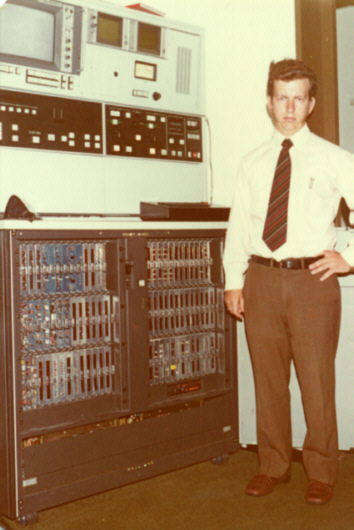 |
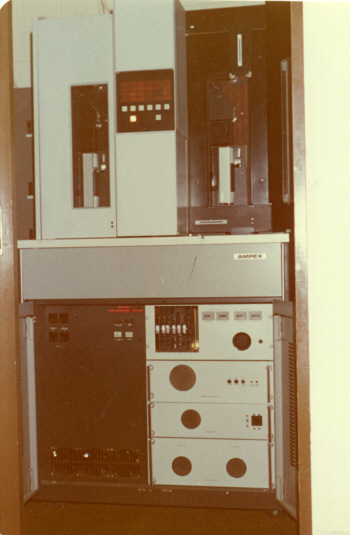 |
Both cabinets in the image above are part of the same machine, the main electronics cabinet on the left and the tape store and transport system on the right. Les was a major mentor to me. Les and Rosie's hospitality left us feeling like we were royalty! A wonderful experience! We spent much time on guided tours of this beautiful part of Australia. An additional bonus was that we could meet up with our son Ian's fiance's family in nearby Lawrence.
One of Les and Rosie's tour destinations was Evans Head. I was particularly interested in Evans Head as I recall flying through this area on many occasions in light aircraft whilst travelling between Bankstown and Archerfield or Brisbane. I used to hope that the RAAF military control zone would be inactive as it being active would require a detour around it. Additionally there is a level of unease associated with flying in the proximity of low flying high speed formidable aircraft. Of course the main activity of the current car tour to Evans Head, was a visit to the Evans Head Memorial Aerodrome and in particular the Evans Head Memorial Aerodrome Heritage Aviation Association's Museum. I had no idea when I walked through the doors of the museum what an exciting treat lay ahead of me.
I was afforded the opportunity to engage in an F111 cockpit experience which the Museum offers to the general public. With the unbelievable coincidence with the F111 documented above and the fact that I have seen most of Australia by light aircraft as a GA pilot, I could not resist this opportunity. I fully expected a museum assistant trained in the basics of F111 operations to conduct the cockpit experience. I could not believe it, when my cockpit tour guide announced he flew C130s and that he had flown the F111 simulator. The experience in an instant, snapped into a level of realism I had not anticipated, which to me was an absolute delight. My tour guide who had instantly transformed into a flight instructor was Rod Kinnish. We quickly established that we both love Twin Comanches. Of course in keeping with all this synchronicity, when I asked Rod if he knew David Rogers, he indicated he knew him.
Rod talked me through a mock startup of the engines, a taxi and take-off. Of course there was no time to go into the details involved in any checklist items, but the details that were presented had me floundering trying to grasp some of the mind blowing aspects of military aviation. Not having been in a cockpit for a few years and not in a gas turbine cockpit for decades I was no doubt mind numbingly slow. I was far too slow triggering the shot clock whilst starting the left hand engine but seemed to rectify that in the right engine cross bleed start. There were a string of brand new concepts like wing sweepback control and exhaust aperture control. I was not allowed to advance the thrust control levers from ground idle, when we were lined up, till I had my head pressed up against the headrest. As Rod described it, there is no other way to put it other than you are riding a rocket. When he called for max thrust I set the thrust control levers to max thrust without afterburners. Rod quickly urged me No no - all the way. I could not believe it - 9000 Kg thrust from each engine - are we going for a vertical climb? I learnt there was no concept of V1 in this aircraft. As I rolled right from runway heading onto the departure track I heard an instruction I never thought I would ever hear reduce thrust now or you will go supersonic. Mach numbers - a new concept for me! Reaction times of a fraction of a second! In all the excitement of the stream of new experiences I totally forgot about all the instinctive things like retracting gear flaps and slats climb checks... There is an aviation experience called getting behind the aircraft which can happen when pilots first fly a considerably faster aircraft than they are used to. I first experienced this when transitioning from the Cherokee Arrow to the Single Comanche. In my first flight in a Single Com, I had just retracted the gear and the aircraft was ready for climb checks. Had I now, after so much more experience, been flying an F111 simulator, I am sure my mind would have still been on the runway whilst the aircraft passed its first waypoint. Obviously several weeks of studying manuals would be an essential prerequisite of undertaking such a gigantic transition to an F111 simulator. And then Rod gave me some lessons on the helicopter simulator, but that is an interesting story in itself and too far removed from the subject of totalisator history coincidence.
Postscript November 2016: Last month when visiting England, I spoke to Ed, my cousin Michaels daughter's husband, who is ex RAF, about this cockpit experience. I informed him that I was amazed that full afterburner was required on take-off. He immediately provided the answer, which seemed obvious once he mentioned it. In my words, the problem was we skipped the pre-flight briefing. I was departing on a local area joy flight without weapons and only short endurance fuel and my instructor was departing on a strike mission with full fuel tanks and full weapons payload. I was delighted with that revelation as it had been puzzling me.
A thrilling experience in a complete F111 at Evans Head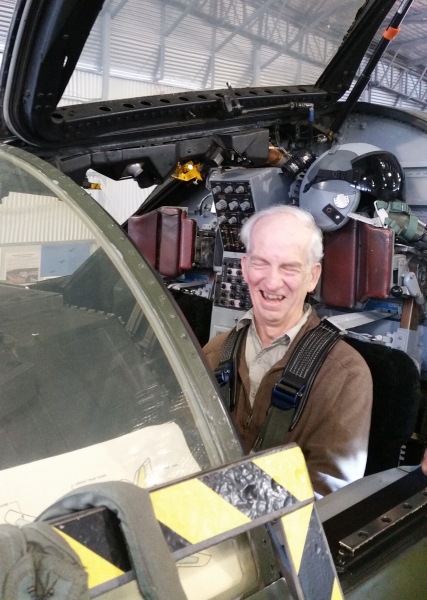
To anyone reading this who is interested in a cockpit experience, but is put off by the technobabble, I am sure these experiences are tailored to each customer and that no prior knowledge is required. I think that for any person with a modicum or even no aviation knowledge, who clambers into this F111 cockpit, that they will exit knowing much more about military aviation. I probably made a fool of myself as a pilot, however at no time was I given that impression and I am left with a wonderful memory that I know will remain for the rest of my days.
I am so impressed with this experience, that I have made an exception to my principle of only putting external links up on the links page of this website and presented a link to the Museum's Website here. I recommend it to anyone wishing to learn about military aviation.
June 2015. I have been looking at the wealth of family information Tony Shellshear, George Julius' great grandson, has provided for me. I have written in the previous page of this website, how I seem to live in places that connect me with totalisator history. I have written about the view from my old home at boarding school, called Street House, showing me an early workplace of mine where I would be working for AWA, which at the Opera House was a subcontractor to George's engineering consulting company Julius Poole and Gibson. I included an image of the view from Street House with this text in the previous page. I have reproduced the Street House image below.
The Western view from Street House in 1964
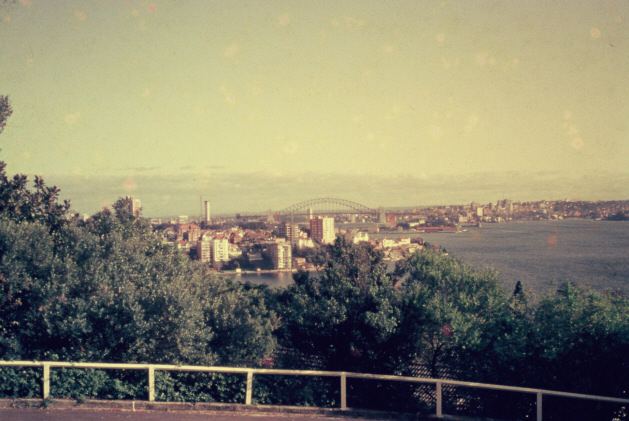
In Tony's documentation I discovered that George Julius' house at Darling point, is at the tip of the headland on the other side of Double Bay in this image. This headland is clearly visible as the landmass projecting from the left hand side of the image into Sydney harbour, with all the apartment blocks on it. I have written in that section about connections between Northwood where I lived and totalisator history, as well as similar connections when I lived in Gordon. There are more connections between this history and locations important to me like Wahroonga in Sydney and Midlands in Perth documented in the previous page of this website. George passed away in his home in Killara and from Tony's documentation, I have discovered that George's wife Eva later lived in a flat in Killara, very close to where I lived in Gordon. Local attractions like the Greengate Hotel and the Marian Street Theatre that I know well, are also close to Eva's flat.
When I retired we moved to Toowoomba thinking that Totalisator History will not catch up with us here. I was wrong! On looking through Tony's Julius memorabilia, I discovered George's 60th Birthday greeting from his friends at Rotary showing a scene from Toowoomba.
Sir George Julius's 60 birthday greeting scene of Toowoomba Range
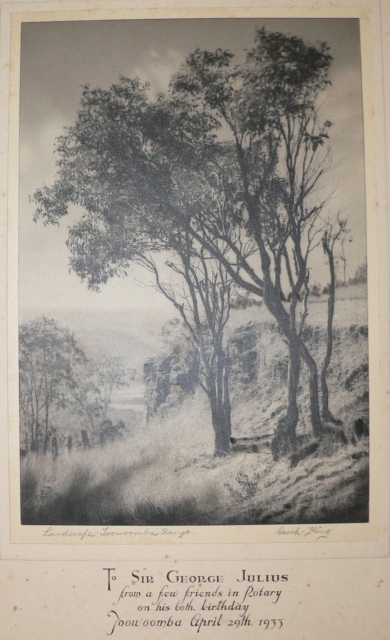
By the time I reached the age that George's card celebrated, Narelle and I had owned a block of land in Toowoomba for many years and a few years after that we were seriously contemplating retirement and moving to Toowoomba, oblivious to George's connection to it.
I have found the reason for the Toowoomba birthday card above in a Trove Newspaper Archive article with the following details: 1933 'SIR GEORGE JULIUS', Maryborough Chronicle, Wide Bay and Burnett Advertiser (Qld. : 1860 - 1947), 1 May, p. 5. , viewed 18 Jun 2017, http://nla.gov.au/nla.news-article149302492
The article reads:
SIR GEORGE JULIUS
TOOWOOMBA, Saturday.
Sir George Julius (president of the Sydney Rotary Club and chairman of the Council for Scientific and Industrial Research) attained his sixtieth birthday to-day. In honour of the occasion, members of the Sydney, North Sydney, Newcastle, Wollongong, Lismore, and Goulburn rotary clubs assembled at the Toowoomba Club, and presented him with a photograph, suitably inscribed.
Mr. B. Gelling eulogised the value of Sir George's public service in various spheres, and Mr. P. D. Riddell (president of thc Newcastle Club) also voiced his appreciation.
Kindly reference was also made to Sir George's father, who was Archbishop and Primate of New Zealand until he retired. He is now in his eighty-sixth year.
In November 2017 after I wrote to Dermot Elworthy, George Julius' great nephew, that there was an Elworthy Street in Toowoomba he wrote the following, which is a connection between George Julius and Toowoomba through family ties:
I'm not surprised that such exists. If you care to blow some dust off the records of the Toowoomba and Darling Downs District Family History Society, (how do I know of these obscure things?!), you will determine that my great Grandfather Edward, then known as a "pastoralist", purchased several large amounts of Government land in Queensland during the middle of the 19th. century. When Toowoomba became a municipality in 1863, Edward, always of entrepreneurial bent, saw an opportunity and bought several blocks in the town, although he lived some distance away in Dalby. I suspect that the street commemorates one or all of these purchases, possibly confirmed in the municipal records.
Dermot mentions his great grandfather Edward Elworthy above. There is an additional coincidence involving Edward and me. Edward emigrated from the UK where he lived in Wellington in Somerset where a relative of mine happens to live. This is documented in the George Julius Genealogy and other latterday interest chapter in the Posthumously section of this website, under the heading Germany and Britain Holiday 2016.
This is not synchronicity however it has to do with my thought that, in coming to Toowoomba this is a place where totalisator history will never find me. In 2018 Narelle and I attended the Weetwood Handicap, as we had wanted to attend a meeting at Clifford Park Racecourse since we moved to Toowoomba four years ago. It had all the appeal of a big city track and it was a nostalgic and enjoyable day. I did not speak to any of the staff at the track as I know that race-club staff are stretched to the limit on carnival days and I presumed there had not been a Julius Tote on this racetrack anyway. It is now four months later and I was going through old Automatic Totalisators Limited documents in search of information on the White City London installations. I was scanning through some of the installation documents, which all are somewhat different as they tend to be snapshots taken at different times. I was flabbergasted when I read in one of these documents about a Julius Tote installation for the Toowoomba Turf Club Queensland. How wrong one can be! I had once again trodden on ground where a Julius Tote had been. The company document is titled JULIUS PREMIER TOTALISATORS, which has a picture of the world on the front cover on which are the words ALL OVER THE WORLD. Also at the bottom of the front cover there are two lines, the first reads: TOTALISATORS LIMITED, and below that in smaller type: 93 PARK STREET, LONDON, W.I. ENGLAND. Totalisators Limited was the U.K. associate company of Automatic Totalisators Limited. The details are Name: Toowoomba Turf Club, Queensland Australia, Type: Win and Place, Runners or Combinations: 40, Indicators: 1, Ticket issuing machines: 8. It is funny that I learn about a Julius Tote in my home town in Australia, from our old associate company in the antipode!
Whilst being amazed by the discovery that there was a Julius Tote in Toowoomba, I happened to notice the following entry in the list of installations, which happened to be Townsville. This caught my attention as Narelle and I were in Townsville a few months ago, entertaining my cousins from Germany who were visiting us for six weeks. Again I had presumed there was no Julius Tote in Townsville. Wrong again! The details are Name: Townsville Turf Club, Queensland Australia, Type: Win and Place, Runners or Combinations: 36, Indicators: 1, Ticket issuing machines: 7.
In March 2016 Narelle and I went to visit friends of ours Kirk and Von in Geelong. On the way we stopped in Melbourne for a few days. There we met with Chris Robertson, an ex high value punter in Victoria with an intense interest in Automatic Totalisators Limited. We stayed at the same place we stayed at during the previous visit which is close to Princes Park. After the first trip to Melbourne we discovered that the place we stayed was on Chris Robertson's doorstep so we decided we would visit him on this trip. Coincidence one. We were on the way to Geelong and as it turns out, this is Chris' home town. Coincidence two. Whilst visiting Kirk and Von in Geelong, Kirk tells me that a friend of his who is on the Institution of Engineers Australia Heritage Committee, informed him that he had completed the work on the recent Julius Tote International Marker, the tote which Automatic Totalisators Limited produced. Naturally Kirk asked his friend if he knew me and he replied in the affirmative. Coincidence three. Whilst we were in Geelong, Kirk and Von took Narelle and I to the National Wool Museum, where I was fascinated seeing a Jacquard Loom working, something I had aspired to for a long time, as this is thought to be the first programmable industrial machine. Rod Richards is an ex Automatic Totalisators Limited employee with an interest in historical machinery. When I wrote to him, expounding my excitement watching this machine in action, he replied informing me of his connection to this very machine! Coincidence four. Following are extracts from his email regarding his son in law Paul:
Claire's husband Paul grew up in the weaving industry and worked as a weaving and factory manager in Sydney. Several years ago now, Paul answered an advertisement for a weaving and factory manager's position, at the Classweave Mill in Geelong. Paul was accepted for the job which he was quite happy about as the Classweave Mill was an old established mill known for quality products. The Jacquard Loom now situated in the museum, was operating in this mill at the time and became part of Paul's responsibility.
And where do you think Rod's daughter Claire works? You guessed it - Geelong!
Having mentioned Rod Richards, a final coincidence, number five, is that at a recent meeting with Rod Richards and his wife Elizabeth, Rod informed me that he met with Rex Turner regularly at a local Bowls Club. I was flabbergasted, I had not heard anything about Rex for around thirty five years and now Rod was the means of our reunion. Furthermore, it was ironic that Rex and Rod had independently met and discovered that they both had worked for the same company Automatic Totalisators Limited, albeit in totally different eras. Finally, what they were not aware of until I informed them, is that Rex had performed the computer totalisator installation in 1978 that replaced the Julius Totalisator at Ipswich Queensland, that Rod had installed in 1950.
There was one final coincidence with Geelong that Dermot informed me of in his November 2017 email mentioned above. He informed me that his ancestor Foster Fyans went to Melbourne before Victoria became a State and was appointed police magistrate in the nascent Geelong. Dermot provided more information in a later email. Following are some extracts:
He made his HQ on the Moorabool river, now known as Fyansford and set about planning present-day Geelong.
He was responsible for the breakwater in Corio Bay, developing the port which at the time became the colony's largest exporter of wool; he constructed a ford across the Barwon river (today the area known as Breakwater) and in 1840 he was appointed commissioner for Crown lands for the Portland Bay district - quite a large area. In 1849 he was reappointed police magistrate and became the inaugural mayor of the Geelong Town Council.
On the previously mentioned subject that totalisator history will not be able to find me here in Toowoomba, I have just received an email from one of my totalisator history contacts on the opposite side of the planet relating his abstract connection with Toowoomba. I hope to meet Neil next year when he visits Australia.
On 21/5/2018 I received an email titled Josiah Dent, from Neil who prefers to be referred to as Neil C, who worked with the Harringay Julius Totalisator in London. Neil wrote the following:
I trust the name in the title means something to you as a resident of Toowoomba. I had recalled a member of my fishing club talking about Toowoomba and having relatives in the area. I saw him today and he tells me that Josiah Dent was his great grandfather's brother. Small world?
Small World indeed. I had to be educated about my own town by a totalisator history connection from the antipode! I have since discovered on the Internet that Josiah was the first Caucasian to be living in what was thought to be the uninhabited swamp that would later become Toowoomba. Later I discovered some history plaques embedded in the pavement outside the Toowoomba Grand Central shopping centre in Margaret street, one of which bears the name Josiah Dent with information about him being the first inhabitant of the area. This discovery originating from the UK is the same as the prior entry relating to the Julius Tote that was installed at Clifford Park in Toowoomba, where the source of the information was the UK.
By the way, Neil has written the most eloquent description of a Julius Totalisator from a non technical viewpoint I have ever read. Following is Neil's description, a user's perception:
As you know I didn't work with the machinery but more on the actual Tote betting side of things. I do recall the machinery - the noise and shiny brass & copper. It had a strange beauty in its mechanical intricacy and component parts that the mechanics lovingly cared for. I wish now I had taken some photos, but I was young then and probably didn't really appreciate how special the equipment was.
On 28/5/2018 Neil wrote again. Following is the body of his email:
Synchronicity. I have just watched the Indianapolis 500 race from the USA. Won by Will Power who was born in Toowoomba! Coincidence or what?
I guess his home town will be celebrating today.
Funny that Neil should mention Will Power. We attended a public Open Day for Wellcamp Airport near Toowoomba, prior to it opening. As a celebration of the completion of the runway, a race was set up down it between Will Power driving a V8 racing car and a Cessna Mustang business jet. The outcome was predictable but exciting.
This next coincidence occurred in Peterborough South Australia when Narelle and I were on our way home from a Chrysler Rally in McLaren Vale near Adelaide in October 2019. We stayed in Peterborough and thought we were going to an outback town with minimalistic facilities but to the contrary found it was a delightful experience missing nothing and ended up spending a second night there. We visited the Steamtown Heritage Rail Centre during the day and also attended the night light and sound show. To set the scene of this light and sound show, you are in a railway carriage that is on top of the old Turntable of the Roundhouse. The side of the carriage, which all the seats face, looks out at an arc of the roundhouse with rolling stock and engines in it. One sits in the carriage and sees a light display on the rolling stock and engines in the roundhouse section. There is also a film that is shown about the history of this once very significant rail centre in Australia, because it was at the intersection of the Ghan and the Transcontinental railway lines. Nothing could have been further from my mind than Automatic Totalisators Limited, as I was lapping up the remoteness and disconnectedness from everything we were accustomed to. Just before the show in the carriage mentioned, there was a bit of an intro to the show we were about to see. They got to the bit about where the carriage we were sitting in was built. They said it was built by the Meadowbank Manufacturing Company. Well I immediately thought Meadowbank England? Meadowbank in South Australia if there is one? And then the announcer said "In Sydney." I could not believe it, I was sitting in outback Australia in a railway carriage that I believed I would have no connection with whatsoever and I find it was built in Meadowbank Sydney where the Automatic Totalisators Limited Head Office and Factory were.
The Meadowbank Manufacturing Company Carriage
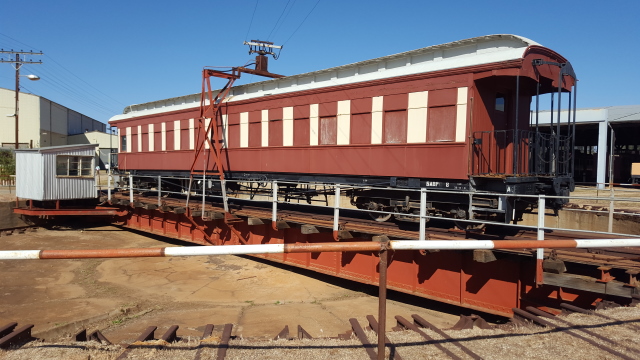
Needless to say I did a bit of investigating and found that the Meadowbank Manufacturing Company was founded in 1890. The founder was Mellor Brothers. Mellor Brothers were a South Australian firm, which established factories in Sydney (Meadowbank Manufacturing Co) and Melbourne (Braybook Implement Co) in 1890. I further discovered that the Meadowbank TAFE sits on some of the land occupied by this factory. This located the Meadowbank Manufacturing Company Factory where this carriage was built, diagonally across Constitution road from the Automatic Totalisators Limited head office and factory where I worked. I also discovered that the house built for the manager of the Meadowbank Manufacturing Company, which was built on the factory grounds and was originally called Bartonville and later was changed to "The Laurels", is still standing. When I saw an image of The Laurels on the Internet I realised I had noticed the house many times during the years of walking past as it is an impressive sandstone one. There is a monument at the northern end of the house on the footpath with the following inscription:
ERECTED BY THE MEN OF THE
MEADOWBANK MANUFACTURING WORKS
IN MEMORY OF THEIR ESTEEMED LATE
WORKS MANAGER
THOMAS [GRANVILLE WILLIAM]
WHITE
RETIRED 1909 DIED 1910
An additional link between the above coincidence and totalisator history is that I have read that George Julius did work on the Transcontinental Railway project, one of the two major Australian railways that passed through the Peterborough railway junction. The last Director of Julius Poole and Gibson, George Julius' engineering consulting company, confirmed that George worked on the Trans Continental Railway project.
It did not take long for the next synchronicity to take place in November 2019. I had just completed adding a historic ATL letter provided by Bill Johnson to one of the pages in the Photo Gallery index above, the one under the heading Early Factory Images with the associated text starting with Some staff outside the Chalmers Street Factory. In adding the text to accommodate this new letter I was reminded that Keith Dodwell, an ex Automatic Totalisators Limited employee who worked on the establishment of this company's American subsidiary company called ATUSA later renamed Autotote, who later became the Executive Vice President of Autotote, had passed away a few years earlier. Since then life has been so hectic that I did not have a moment to think about it since. I was slightly surprised when my computer announced the arrival of an Email a minute or so after I uploaded this new version to the Internet that confirmed Keith Dodwell was indeed in the staff image in that Photo Gallery page. The Email arrived at 10:14PM on Black Friday 29th November, as I was preparing to shut the system down for the night. I changed my mind and decided to read the email before shutting down, as I was incredulous after reading the subject which read Remembering keith Dodwell!!! The body of the email showed an image of a burning candle with the words Remembering above and keith Dodwell below, followed by Dear Family and Friends of Keith Dodwell, followed by more information soliciting new entries in Keith's memorial guest book starting with the sentence Being remembered matters! I had no idea that my work on this page was just over a day prior to the anniversary of his passing. The words Being remembered matters are of particular significance to me as my mother said when she knew she was terminally ill, no one really dies until the last person who remembers them dies!

- Thanks to Jan Harkin from the State Library NSW for informing me that the image of the Automatic Totalisators factory in Chalmers Street is out of copyright and can be displayed on this site.
- Thanks to Bob Plemel for hosting these images
- Thanks to Frank Matthews for the loan of many and donation of the above photographs all relating to totalisator history
- Thanks to Diane McCarthy for her assistance with investigating the early Automatic Totalisators factories
- The photographer's stamp Photo by Ray B. Dame appears on all the Hialeah racetrack in Miami 1932 section photographs
- Thanks to Ian my 11 year old son (1997) who was a great help with the typing, the html and the images.

Comments and suggestions welcome to
totehis@hotmail.com 









